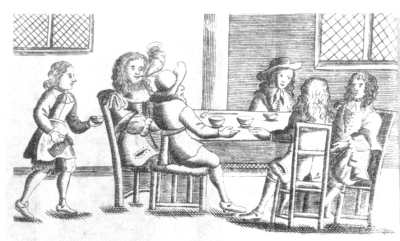The Historical and Cultural significance of Coffee Eastern drinks and Western cultures

The Historical and Cultural significance of Coffee: eastern Beverage and Western Culture
This is the earliest painting known about a British cafe. This 1674 woodcut comes from a single page of Paul Greenwood's ad entitled "the virtues of sober and wholesome coffee drinks."
Coffee, a familiar but mysterious drink, is like a strong wind blowing into our world from the west, and gradually changing our lives and temperament. You may be obsessed with its bitter and mellow smell, its romantic and slightly melancholy implication, or its European little bourgeois style. But have you ever tried to taste and understand the western culture it contains from its history, its popularity and evolution?
The hometown of coffee is in the southern part of the Ethiopian plateau in Africa. It was discovered around the 6th century AD. Because of its refreshing effect, local people began to chew coffee beans and drink coffee with water. This atmosphere began in Ethiopia and spread to Arab countries, and soon became a representative drink in Islamic countries. In the early 17th century, the Englishman Santis first met coffee in Constantinople, the capital of the Ottoman Empire (present-day Turkey). After that, coffee became familiar and infatuated by more and more Europeans as a medicine and "oriental drink".
In 1652, the first coffee shop appeared in London, England, and it was also the first coffee shop in the Christian world. (cultural History of Cafe, by Markman Ellis, translated by Meng Li and Chen Guangxing, Guangxi normal University Press, 2007, p. 34) By the end of the 1660s, cafes had appeared in many British cities. In 1670, the first coffee shop outside England appeared in Boston, a colonial city in the Bay of Massachusetts in North America, in Paris in 1671, Vienna in 1685, New York in 1696, Venice in 1720, and Rome in 1750. Countless "firsts" came one after another. Since then, this drink has conquered the western world with a gentle but strong momentum. It is in the cafes on street corners and by the side of the road, in cups of bitter liquid floating with fragrance, and in the hustle and bustle one after another, that great political thoughts have emerged, giving birth to withered modern political changes, the industrial revolution sweeping the world, the birth of ancient and modern literary and artistic works, and the formation of western social culture.
Since the beginning of the cafe, there has been a paradigm of social communication. It reflects the willingness of people to stay together and communicate. In the cafe, everyone is equal, regardless of status and origin, the concrete manifestation is the "egalitarianism on the seat" of the cafe. No matter who buys a cup of coffee, he can get a chair in the cafe and sit for as long as he wants. People have an equal right to speak when they drink coffee, express their opinions, and sometimes even quarrel. People regard the cafe as a place to express their opinions, exchange views and get news, and it seems to play a role like the information network system in today's society. Under the influence of coffee, people are clear-headed and energetic. They try their best to express their dissatisfaction with the current system and the design of the ideal system. They try their best to gain knowledge and increase knowledge from the communication with others. They try their best to search their brains for creative inspiration and realistic materials. In this way, in the seemingly chaotic cafes, Republicans and conservatives in the English Civil War broke out a debate about republicanism, which promoted the process of the British Revolution; the French Enlightenment thinkers exchanged disputes, which formed their own modern social and political theories and gave birth to the French Revolution. As a result, the cafe is clearly regarded as the guidepost of the modern revolution and exists silently and indispensably in history.
After the 18th century, with the development of industrial society, the intensification of social differentiation and the refinement of social division of labor, cafes declined to varying degrees, and "egalitarianism on the seat" was gradually broken. Caf é s are also divided, with aristocrats and upper classes gathering in high-end cafes for entertainment. Simple and inexpensive forms of making and selling coffee have also been developed, most typically coffee bars and coffee stalls. However, as an important part of daily diet, the historical and cultural effect of coffee has not diminished. The most typical example is the role of coffee in promoting the industrial revolution. Warm and refreshing coffee was an important soothing and supportive product for workers in the industrial revolution. They live in poor conditions, work extremely long hours and have no time to prepare three meals. Coffee and bread become sacred food. Coffee has also changed from an aristocratic drink to a necessary refreshing agent for the working class, fostering a common understanding among the workers.
In addition, coffee has a group of great believers who can not be ignored in history. They have made great contributions to western culture, and their works can be called treasures in the history of human civilization. The publication of these works is inseparable from the company of cups of strong coffee: Balzac drank 50,000 cups of coffee all his life while writing "Human Comedy"; the Dutch post-impressionist painter Van Gogh was obsessed with the world staged in the cafe. Again and again he pushed open the door of the Algasa Cafe which was still open at night and recorded the scene in the cafe with a paintbrush. German musician Bach's coffee-themed cantata, also known as Coffee cantata (cantata: a genre of large vocal suites), achieves the perfect combination of coffee and music. Sartre, a famous philosopher, continued to write every day in Paris even when the air raid sirens sounded and the city was in chaos during World War II. There are many such examples. This group of people have a devotion to truth, a yearning for art and a pursuit of beauty. Coffee is not the reason for the publication of his works, but how important it is to them!
As an "oriental drink", coffee is endowed with great western meaning. For hundreds of years, this mellow bitterness attracted all kinds of people, and therefore permeated all fields of modern western society, flowing like blood in the land of Europe for centuries. Today, it has become a typical representative of western culture, and once again returned to the eastern world. This is the beauty of the history of coffee development, but also the attraction of coffee culture.
(author: school of History, Beijing normal University)
Important Notice :
前街咖啡 FrontStreet Coffee has moved to new addredd:
FrontStreet Coffee Address: 315,Donghua East Road,GuangZhou
Tel:020 38364473
- Prev

Common sense of Coffee Culture Queenstown and Coffee Culture in New Zealand
The leisurely temperament of Queenstown is similar to the coffee culture of New Zealand. The coffee in the small town coffee shop is full of ingredients with hamburger New Zealand coffee. The fragrant New Zealand winery trip is also famous for the ancient tram restaurant in Christchurch. There is also delicious coffee to provide some cafes to print their own T-shirts, postcards and so on for tourists to choose and buy Wentu / Yangcheng Evening News reporter Liu Xingtong.
- Next

The basic knowledge of Coffee Culture the Coffee Story of Napoleon and St. Helena
Napoleon is a legendary man who knows how to enjoy. He likes to take a special carriage carrying his favorite Chambertin wine when he goes to war. He invented the brewing method of brandy coffee (that is, royal coffee) and carried a Turkish bean grinder with him, paying special attention to the quality of life while fighting the war. After his defeat, he was imprisoned on St. Helena Island, where wine was no longer enjoyed every day.
Related
- How did the Salvadoran coffee industry develop in Central America?
- What exactly does the golden cup extraction of coffee mean?
- The Origin of Coffee flower
- [2023 Starbucks World Earth Day] there are more meaningful things besides free Starbucks coffee!
- What kind of coffee is there in Spain? 9 Flavors of Spanish Coffee
- Aromatic African coffee| Kenya's coffee culture and historical production area
- Liberica Coffee Bean knowledge: the characteristics of Liberian Coffee beans of the three original species of Coffee beans
- The origin and formula of Spanish latte introduces the taste characteristics of Bombon coffee in Valencia, Spain.
- How to adjust the solution of over-extracted coffee
- What is the tasting period of coffee beans? What is the period of coffee and beans? How should coffee wake up and raise beans?

